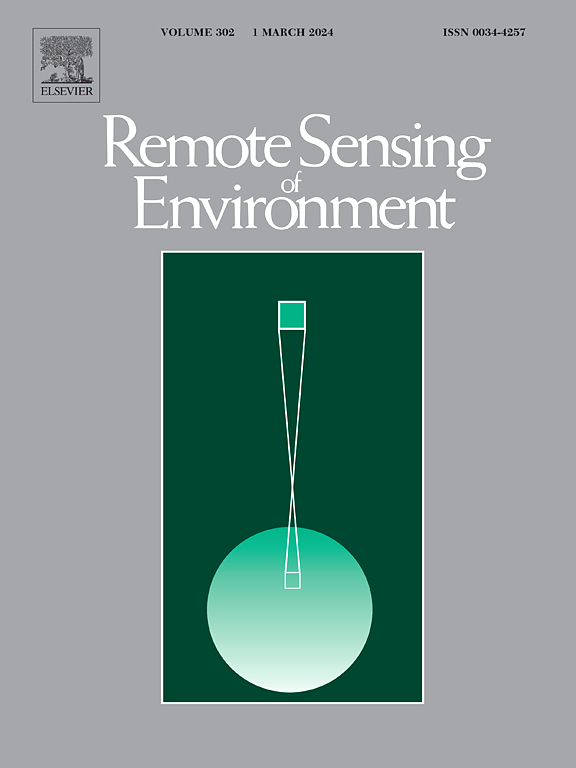Multi-modal deep learning approaches to semantic segmentation of mining footprints with multispectral satellite imagery
IF 11.1
1区 地球科学
Q1 ENVIRONMENTAL SCIENCES
引用次数: 0
Abstract
Existing remote sensing applications in mining are often of limited scope, typically mapping multiple mining land covers for a single mine or only mapping mining extents or a single feature (e.g., tailings dam) for multiple mines across a region. Many of these works have a narrow focus on specific mine land covers rather than encompassing the variety of mining and non-mining land use in a mine site. This study presents a pioneering effort in performing deep learning-based semantic segmentation of 37 mining locations worldwide, representing a range of commodities from gold to coal, using multispectral satellite imagery, to automate mapping of mining and non-mining land covers. Due to the absence of a dedicated training dataset, we crafted a customized multispectral dataset for training and testing deep learning models, leveraging and refining existing datasets in terms of boundaries, shapes, and class labels. We trained and tested multimodal semantic segmentation models, particularly based on U-Net, DeepLabV3+, Feature Pyramid Network (FPN), SegFormer, and IBM-NASA foundational geospatial model (Prithvi) architecture, with a focus on evaluating different model configurations, input band combinations, and the effectiveness of transfer learning. In terms of multimodality, we utilized various image bands, including Red, Green, Blue, and Near Infra-Red (NIR) and Normalized Difference Vegetation Index (NDVI), to determine which combination of inputs yields the most accurate segmentation. Results indicated that among different configurations, FPN with DenseNet-121 backbone, pre-trained on ImageNet, and trained using both RGB and NIR bands, performs the best. We concluded the study with a comprehensive assessment of the model's performance based on climate classification categories and diverse mining commodities. We believe that this work lays a robust foundation for further analysis of the complex relationship between mining projects, communities, and the environment.基于多光谱卫星图像的采矿足迹语义分割的多模态深度学习方法
采矿方面现有的遥感应用往往范围有限,通常为一个矿山测绘多个采矿土地覆盖,或为一个区域的多个矿山仅测绘采矿范围或单一特征(例如尾矿坝)。这些工作中有许多只局限于具体的矿山土地覆盖,而不包括矿区采矿和非采矿土地的各种用途。本研究提出了一项开创性的工作,使用多光谱卫星图像对全球37个矿区进行基于深度学习的语义分割,这些矿区代表了从黄金到煤炭的一系列商品,以自动绘制采矿和非采矿土地覆盖。由于缺乏专门的训练数据集,我们制作了一个定制的多光谱数据集,用于训练和测试深度学习模型,利用和改进现有数据集的边界、形状和类标签。我们训练和测试了多模态语义分割模型,特别是基于U-Net、DeepLabV3+、特征金字塔网络(FPN)、SegFormer和IBM-NASA基础地理空间模型(Prithvi)架构,重点评估了不同的模型配置、输入频带组合和迁移学习的有效性。在多模态方面,我们使用了不同的图像波段,包括红、绿、蓝、近红外(NIR)和归一化植被指数(NDVI),以确定哪种输入组合产生最准确的分割。结果表明,采用DenseNet-121骨干网,在ImageNet上进行预训练,并同时使用RGB和NIR波段进行训练的FPN在不同配置下表现最佳。最后,我们根据气候分类类别和不同的采矿商品对模型的性能进行了综合评估。我们相信,这项工作为进一步分析采矿项目、社区和环境之间的复杂关系奠定了坚实的基础。
本文章由计算机程序翻译,如有差异,请以英文原文为准。
求助全文
约1分钟内获得全文
求助全文
来源期刊

Remote Sensing of Environment
环境科学-成像科学与照相技术
CiteScore
25.10
自引率
8.90%
发文量
455
审稿时长
53 days
期刊介绍:
Remote Sensing of Environment (RSE) serves the Earth observation community by disseminating results on the theory, science, applications, and technology that contribute to advancing the field of remote sensing. With a thoroughly interdisciplinary approach, RSE encompasses terrestrial, oceanic, and atmospheric sensing.
The journal emphasizes biophysical and quantitative approaches to remote sensing at local to global scales, covering a diverse range of applications and techniques.
RSE serves as a vital platform for the exchange of knowledge and advancements in the dynamic field of remote sensing.
 求助内容:
求助内容: 应助结果提醒方式:
应助结果提醒方式:


